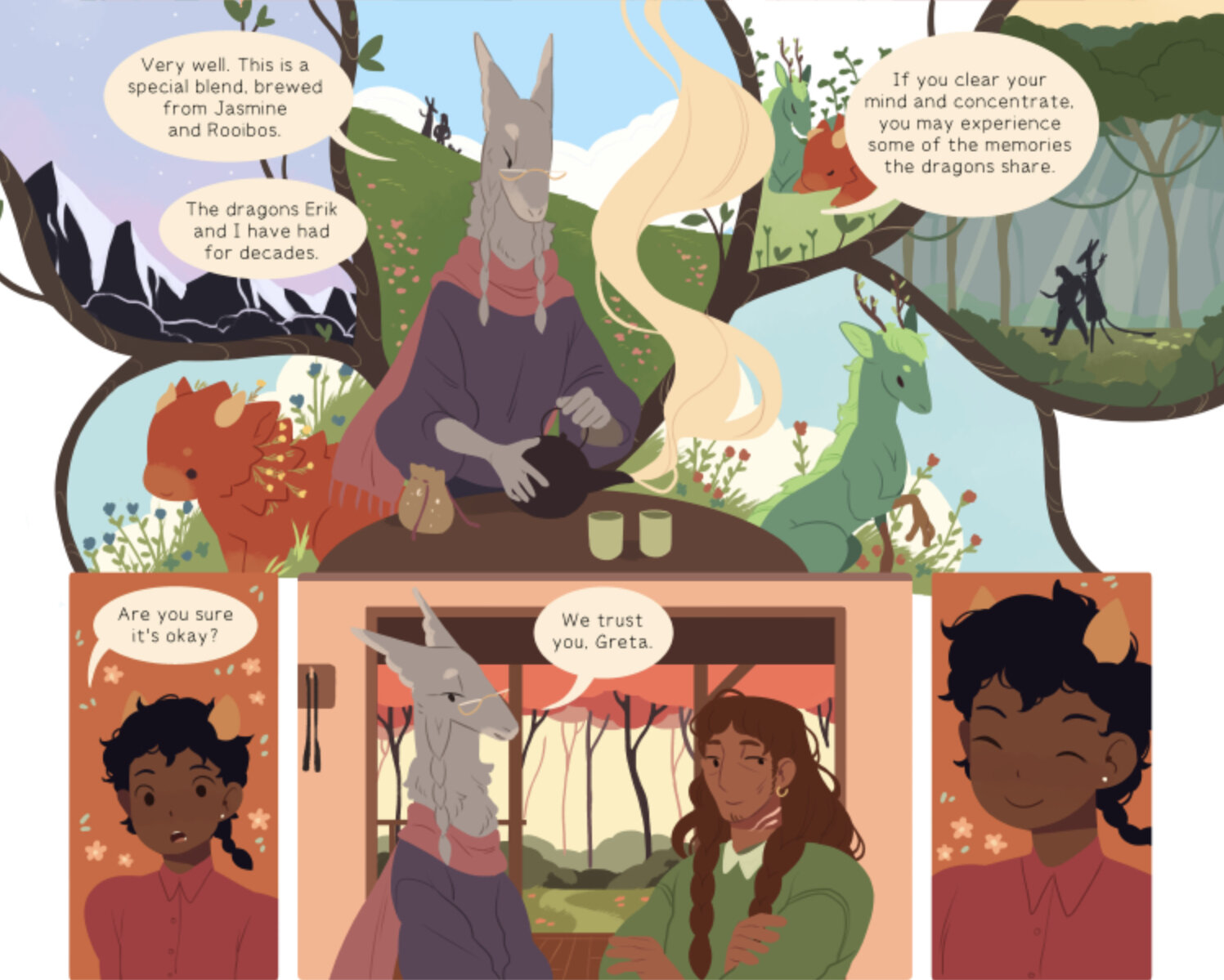The Tea Dragon Society is a comic short story created by Katie O’Neill. Greta is a blacksmith apprentice who struggles with finding purpose in a craft that doesn’t seem appreciated anymore. Her questioned is eventually answered when she meets Hezekiel and Erik, the last remaining members of the Tea Dragon Society, a group who takes care of the rare miniature dragons that sprout tea from their bodies. Greta also becomes close the forgetful and bashful Minette, who also has her own tea dragon. All three of them show Greta the importance of community and taking care of those around you.
How can ambivalence not only be depicted, but also used to enrich character analyses?
When creating and discussing characters, it’s only natural to want to define them in absolute terms. This character is head-strong for these reasons… This other character has issues communicating because of this… Discussing characters like this is easy because of how straight-forward it is — this blog has certainly featured analyses like these before — and it also taps into our human need for neat categories. Nonetheless, playing with these well defined lines is much more fun, and this is achieved by creating ambivalence or, in other words, the validity of both options. The Tea Dragon Society introduces ambivalence in their character designs through its namesake tea dragons which function as familiars, which are animal partners that share a deep bond with their partner. Depending on the text they can be extensions of the self, protectors, sources of power… In popular culture, familiars are associated with witches and black cats, for instance, but you can also see them in His Dark Materials as Daemons, or as Digimon partners. We love stories that feature animal partners.
Credit: Katie O’Neill
A four-panel page.
First panel: Hezekiel is pouring a cup of tea. There are various images around him depicting snapshots of his time adventuring with Erik and their tea dragons.
Hezekiel: Very well. This is a special blend, brewed from Jasmine and Rooibos. If you clear your mind and concentrate, you may experience some of the memories the dragons share.
Second panel: A close-up of Greta, surprised.
Greta: Are you sure it’s okay?
Third panel: Hezekiel and Erik are standing close together with a soft look on their faces, a large window facing the woods behind them.
Hezekiel: We trust you, Greta.
Fourth panel: A close-up of Greta, eyes closed and smiling, delighted.
Just as familiars vary by the kind of bond that they have with their partner, they can also vary by the symbolism that defines their paring. On one hand, the familiar and partner can mirror each other physically. For example, Hezekiel and Jasmine are both tall, long, and slender. Their features are angular and delicate, and they both carry themselves calmly and gracefully. This contrasts with Erik and Rooibos, who are stockier and have more rounded features. They give off physical strength and heartiness, and their skin tones are evocative of homely, grounded living. On the other hand, the familiar and partner can also mirror each other in a more symbolic way. The same way that jasmine tea is associated with eternal love in Chinese culture, this meaning can also be extended to Hezekiel by proxy of his familiar. It is undeniable that Hezekiel exudes a loving disposition, especially when it comes to Erik and staying by his side all of these years. In short, familiars and partners mutually imbue each other with symbolic meaning.
Credit: Katie O’Neill
A seven-panel page.
First panel: Minette and Great are standing on a bridge at sunset. Minette is looking at Greta, surprised, while Greta greets Minette with a warm smile. Greta’s forge spirit Brick is on the bridge’s guard, and Chamomile is at Minette’s heels.
Minette: Did I?
Second panel: A close-up of Greta, winking and pointing behind her with her thumb.
Greta: The road to the tea house is just around that corner. You’re almost there.
Third panel: A close-up of Minette, wide-eyed and surprised.
Fourth panel: Another close-up of Minette slightly blushing and looking timidly relived and content.
Fifth panel: Minette is laughing to herself with an illustration of cherry blossoms on a branch as a backdrop.
Minette: I’m so glad! I was pretty certain I had it.
Sixth panel: Minette rests her head of Greta’s shoulder, contentedly. Greta looks at her form the side, blushing and happy. Brick is staring at both of them.
Minette: But it’s strange, you know... ...Just as I was starting to get a little afraid, you showed up.
Seventh panel: A wide shot of the sunset from the bridge. Minette and Greta, from behind, are standing in the middle of the bridge with Minette’s head still on Greta’s shoulder.
The complete opposite can also be true, however, and therein lies the value of ambivalence. In The Tea Dragon Society, this is achieved in terms of lack; while the tea dragons are symbolic representations of their partners, they also symbolize what their partners need for their fulfillment. This is exemplified easily with Minette’s relationship with Chamomile. Just as before, they reflect each other physically with their horns, ears, skin tone, and soft design; however, Minette struggles with her memory. While this is a source of worry and anxiety that keeps her from enjoying her life, she is paired with Chamomile, whose tea is commonly used to calm down and alliviate pain. The same way that a tea dragon needs someone to nurture it, the caretaker has something to gain and learn from the tea dragon itself. Overall, the potential that a symbol like a familiar presents to a creator and reader is definitely rich because a familiar that can simultaneously reflect and contrast its partner isn’t a flaw but a boon. The possibility of two valid interpretations doesn’t weaken the characters but rather enriches the text as different readers will draw their own connections and conclusions through their own knowledge and experiences.

